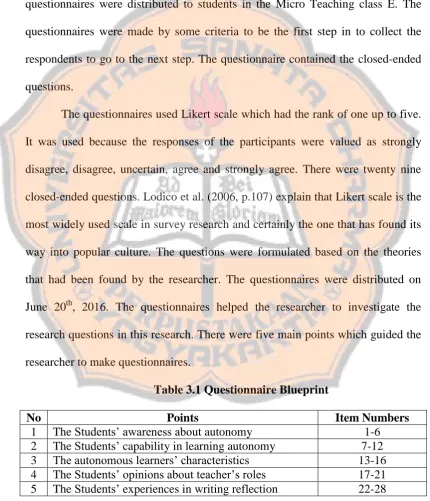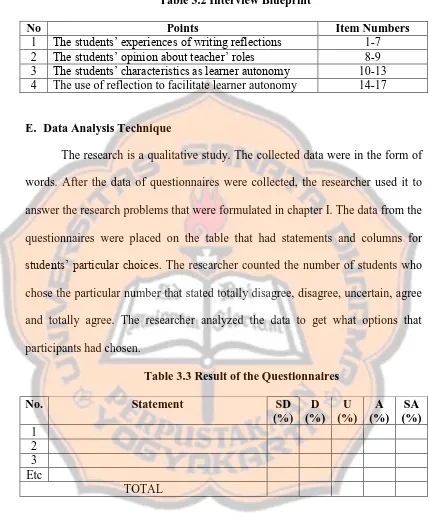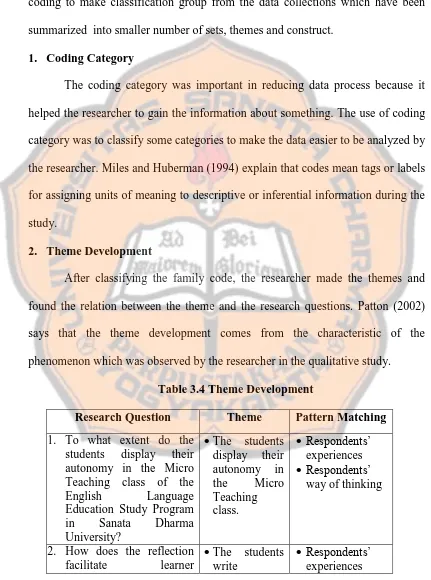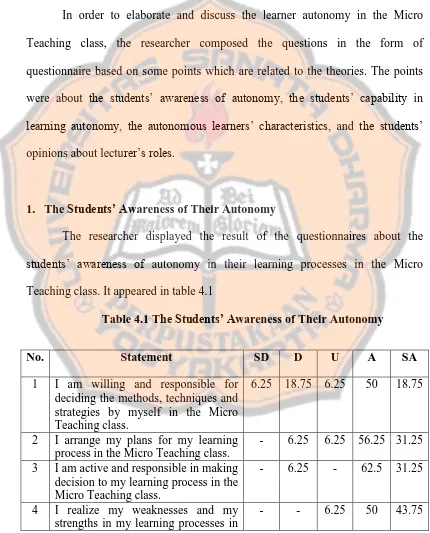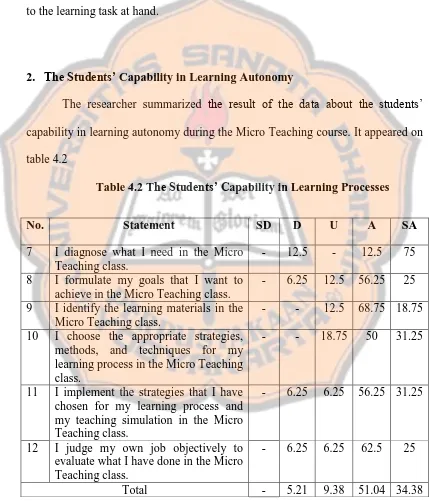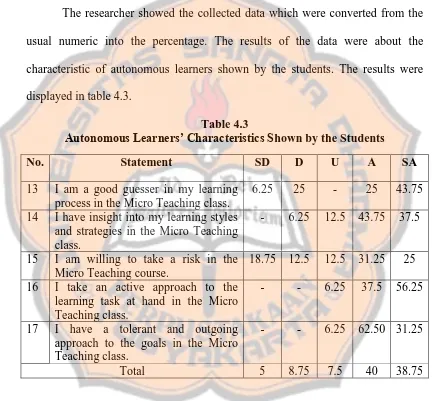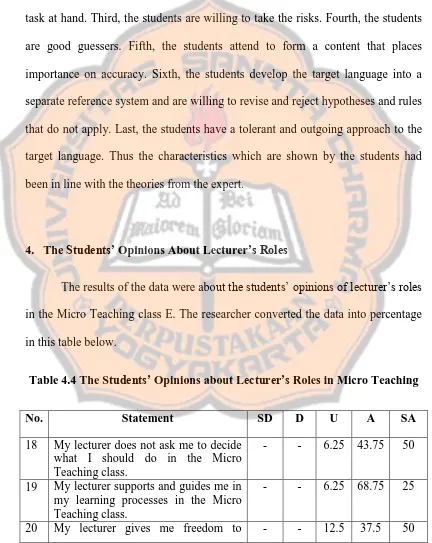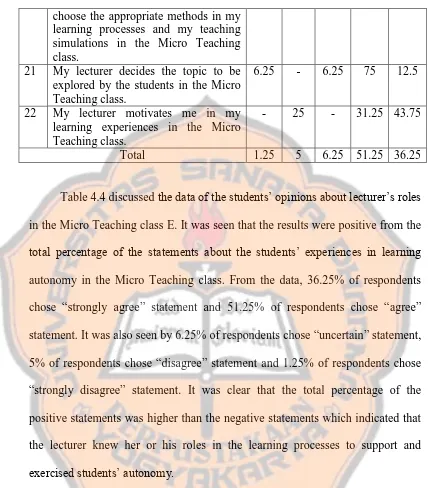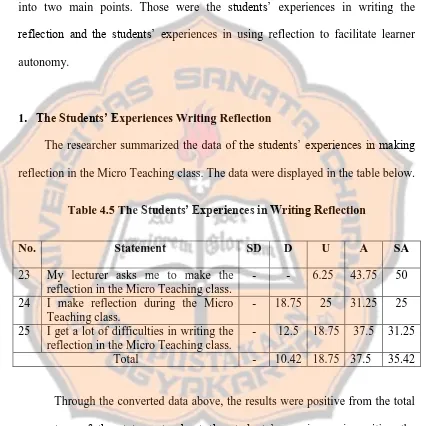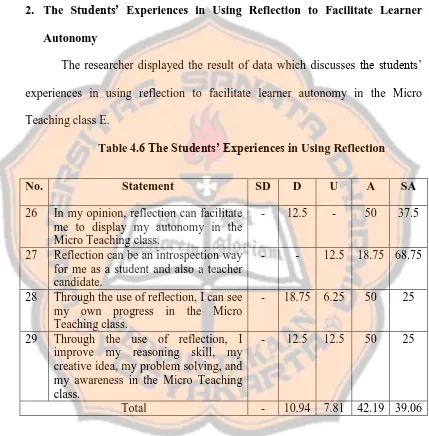ABSTRACT
Christanti, Avysta. (2016). The Use of Reflection to Facilitate Learner Autonomy in Micro Teaching Class E. Yogyakarta: Sanata Dharma University.
Learner autonomy is important to be developed so that the students can use their capacity in their learning processes. This study focuses on the students’ capacity to display their autonomy in the Micro Teaching class. Learner autonomy can be facilitated by students’ reflections. This research investigates the use of reflection to facilitate learner autonomy in the Micro Teaching class of the English Language Education Study Program in Sanata Dharma University.
There are two research problems and objectives which have been formulated in this research. The research problems of this research are: (1) To what extent do the students display their autonomy in the Micro Teaching class of the English Language Education Study Program in Sanata Dharma University? And (2) How does the reflection facilitate learner autonomy in the Micro Teaching class of the English Language Education Study Program in Sanata Dharma University?
The research employed a qualitative study. The researcher gathered the data by conducting observation, distributing the questionnaires and conducting the interview. This research employed multiple sources of data in order to allow data triangulation. The participants of the research were sixteen students in the Micro Teaching class E of the English Language Education Study Program in Sanata their autonomy in terms of using their capacity in their learning processes in the Micro Teaching class. The students were able to show the characteristics of autonomous learners and foster their awareness of their autonomy in the Micro Teaching class. The use of reflection facilitated the exercise of learner autonomy in the Micro Teaching class. Reflection became a medium for the students to raise their awareness and get problem solving in their learning processes. The students used the reflection to evaluate their progress, improvement and development in their own learning processes in the Micro Teaching class. The students could use reflection to facilitate learner autonomy in the Micro teaching class E by identifying and writing down their weaknesses, strengths, problems, and obstacles; formulating their goals; arranging their plans and evaluating what they had done in written reflection.
ABSTRAK
Christanti, Avysta. (2016). The Use of Reflection to Facilitate Learner Autonomy in Micro Teaching Class E. Yogyakarta: Universitas Sanata Dharma.
Otonomi pembelajar penting untuk dikembangkan sehingga mahasiswa mampu menggunakan kapasitas kemampuan mereka dalam proses belajar. Studi ini fokus pada kapasitas mahasiswa untuk menampilkan otonomi mereka dalam kelas micro teaching. Otonomi pembelajar dapat difasilitasi dengan refleksi mahasiswa. Penelitian ini menyelidiki tentang penerapan reflkesi unuk memfasilitasi otonomi pembelajar di kelas micro teaching dari Program Studi Pendidikan Bahasa Inggris di Universitas Sanata Dharma.
Ada dua masalah penelitian dan tujuan dalam penelitian ini. Masalah-masalah yang telah dirumuskan dalam penelitian ini adalah: (1) Sejauh apakah mahasiswa menampilkan otonomi mereka di kelas micro teaching dari Program Studi Pendidikan Bahasa Inggris di Universitas Sanata Dharma? Dan (2) Bagaimana refleksi memfasilitasi otonomi pembelajar dalam kelas micro teaching dari Program Studi Pendidikan Bahasa Inggris di Universitas Sanata Dharma?
Penelitian ini menggunakan studi kualitatif. Peneliti mengumpulkan data dengan melakukan pengamatan, mendistribusikan kuesioner dan melakukan wawancara. Penelitian ini menggunakan beberapa sumber untuk penggunaan triangulasi data. Peserta penelitian berjumalah enam belas mahasiswa di kelas micro teaching dari Program Studi Pendidikan Bahasa Inggris di Universitas Sanata Dharma. Penelitian ini menggunakan purposive sampling untuk memilih peserta untuk diwawancara.
Temuan menunjukkan bahwa mahasiswa melatih otonomi mereka. Hasil dari kuesionair yang didukung oleh pengamatan dan wawancara menunjukkan bahwa hal ini berjalan sangat baik dan hasilnya sangat tinggi. Mereka menunjukkan otonomi mereka dalam penggunaan kapasitas mereka dalam proses belajar di kelas micro teaching. Mahasiswa mampu menampilkan karakteristik dari pelajar yang otonom dan mampu menumbuhkan kesadaran akan otonomi mereka di kelas micro teaching. Penggunaan refleksi memfasilitasi latihan dari otonomi pembelajar. Refleksi menjadi sebuah media untuk meningkatkan kesadaran dan kemampuan memecahan masalah dalam proses pembelajaran mereka. Mahasiswa juga menggunakan refleksi sebagai alat untuk mengevaluasi perkembangan mereka, perbaikan dan pengembangan dalam proses belajar mereka di kelas micro teaching. Mahasiswa dapat menggunakan refleksi untuk memfasilitasi pembelajar otonom di micro teaching kelas E dengan mengidentifikasi dan menulis kekurangan, kelebihan, masalah, rintangan; merumuskan tujuan mereka; mengatur rencana mereka dan mengevaluasi apa saja yang telah mereka lakukan dalam refleksi tertulis.
THE USE OF REFLECTION
TO FACILITATE LEARNER AUTONOMY IN MICRO TEACHING CLASS E
A SARJANA PENDIDIKAN THESIS
Presented as Partial Fulfillment of the Requirements to Obtain the Sarjana Pendidikan Degree
in English Language Education
By
Avysta Christanti Student Number: 121214072
ENGLISH LANGUAGE EDUCATION STUDY PROGRAM DEPARTMENT OF LANGUAGE AND ARTS EDUCATION FACULTY OF TEACHERS TRAINING AND EDUCATION
SANATA DHARMA UNIVERSITY YOGYAKARTA
i
THE USE OF REFLECTION
TO FACILITATE LEARNER AUTONOMY IN MICRO TEACHING CLASS E
A SARJANA PENDIDIKAN THESIS
Presented as Partial Fulfillment of the Requirements to Obtain the Sarjana Pendidikan Degree
in English Language Education
By
Avysta Christanti Student Number: 121214072
ENGLISH LANGUAGE EDUCATION STUDY PROGRAM DEPARTMENT OF LANGUAGE AND ARTS EDUCATION FACULTY OF TEACHERS TRAINING AND EDUCATION
SANATA DHARMA UNIVERSITY YOGYAKARTA
iv
Finish what
you started.
vii ABSTRACT
Christanti, Avysta. (2016). The Use of Reflection to Facilitate Learner Autonomy in Micro Teaching Class E. Yogyakarta: Sanata Dharma University.
Learner autonomy is important to be developed so that the students can use their capacity in their learning processes. This study focuses on the students’ capacity to display their autonomy in the Micro Teaching class. Learner autonomy can be facilitated by students’ reflections. This research investigates the use of reflection to facilitate learner autonomy in the Micro Teaching class of the English Language Education Study Program in Sanata Dharma University.
There are two research problems and objectives which have been formulated in this research. The research problems of this research are: (1) To what extent do the students display their autonomy in the Micro Teaching class of the English Language Education Study Program in Sanata Dharma University? And (2) How does the reflection facilitate learner autonomy in the Micro Teaching class of the English Language Education Study Program in Sanata Dharma University?
The research employed a qualitative study. The researcher gathered the data by conducting observation, distributing the questionnaires and conducting the interview. This research employed multiple sources of data in order to allow data triangulation. The participants of the research were sixteen students in the Micro Teaching class E of the English Language Education Study Program in Sanata Dharma University. The research used purposive sampling in order to select the participants to be interviewed.
The findings showed that the students exercised their autonomy. The results of the questionnaires which were supported by the observation and the interview showed that it was going well and very high. The students displayed their autonomy in terms of using their capacity in their learning processes in the Micro Teaching class. The students were able to show the characteristics of autonomous learners and foster their awareness of their autonomy in the Micro Teaching class. The use of reflection facilitated the exercise of learner autonomy in the Micro Teaching class. Reflection became a medium for the students to raise their awareness and get problem solving in their learning processes. The students used the reflection to evaluate their progress, improvement and development in their own learning processes in the Micro Teaching class. The students could use reflection to facilitate learner autonomy in the Micro teaching class E by identifying and writing down their weaknesses, strengths, problems, and obstacles; formulating their goals; arranging their plans and evaluating what they had done in written reflection.
viii ABSTRAK
Christanti, Avysta. (2016). The Use of Reflection to Facilitate Learner Autonomy in Micro Teaching Class E. Yogyakarta: Universitas Sanata Dharma.
Otonomi pembelajar penting untuk dikembangkan sehingga mahasiswa mampu menggunakan kapasitas kemampuan mereka dalam proses belajar. Studi ini fokus pada kapasitas mahasiswa untuk menampilkan otonomi mereka dalam kelas micro teaching. Otonomi pembelajar dapat difasilitasi dengan refleksi mahasiswa. Penelitian ini menyelidiki tentang penerapan reflkesi unuk memfasilitasi otonomi pembelajar di kelas micro teaching dari Program Studi Pendidikan Bahasa Inggris di Universitas Sanata Dharma.
Ada dua masalah penelitian dan tujuan dalam penelitian ini. Masalah-masalah yang telah dirumuskan dalam penelitian ini adalah: (1) Sejauh apakah mahasiswa menampilkan otonomi mereka di kelas micro teaching dari Program Studi Pendidikan Bahasa Inggris di Universitas Sanata Dharma? Dan (2) Bagaimana refleksi memfasilitasi otonomi pembelajar dalam kelas micro teaching dari Program Studi Pendidikan Bahasa Inggris di Universitas Sanata Dharma?
Penelitian ini menggunakan studi kualitatif. Peneliti mengumpulkan data dengan melakukan pengamatan, mendistribusikan kuesioner dan melakukan wawancara. Penelitian ini menggunakan beberapa sumber untuk penggunaan triangulasi data. Peserta penelitian berjumalah enam belas mahasiswa di kelas micro teaching dari Program Studi Pendidikan Bahasa Inggris di Universitas Sanata Dharma. Penelitian ini menggunakan purposive sampling untuk memilih peserta untuk diwawancara.
Temuan menunjukkan bahwa mahasiswa melatih otonomi mereka. Hasil dari kuesionair yang didukung oleh pengamatan dan wawancara menunjukkan bahwa hal ini berjalan sangat baik dan hasilnya sangat tinggi. Mereka menunjukkan otonomi mereka dalam penggunaan kapasitas mereka dalam proses belajar di kelas micro teaching. Mahasiswa mampu menampilkan karakteristik dari pelajar yang otonom dan mampu menumbuhkan kesadaran akan otonomi mereka di kelas micro teaching. Penggunaan refleksi memfasilitasi latihan dari otonomi pembelajar. Refleksi menjadi sebuah media untuk meningkatkan kesadaran dan kemampuan memecahan masalah dalam proses pembelajaran mereka. Mahasiswa juga menggunakan refleksi sebagai alat untuk mengevaluasi perkembangan mereka, perbaikan dan pengembangan dalam proses belajar mereka di kelas micro teaching. Mahasiswa dapat menggunakan refleksi untuk memfasilitasi pembelajar otonom di micro teaching kelas E dengan mengidentifikasi dan menulis kekurangan, kelebihan, masalah, rintangan; merumuskan tujuan mereka; mengatur rencana mereka dan mengevaluasi apa saja yang telah mereka lakukan dalam refleksi tertulis.
ix
ACKNOWLEDGEMENTS
I thank my Lord for His love which is given to my life. He gives me strengths and patience so that everything was possible to be done. He is always present in every single second on the processes of completing this thesis.
I would like to thank my advisor, Veronica Triprihatmini, M.Hum., M.A. for her limitless patience to guide and help me during writing my thesis. I got a lot of knowledge and lessons from her. I also thank my academic advisor (DPA), Agustinius Hardi Prasetyo, S.Pd., M.A. for helping me in this study program. I also thank all the lecturers and staff of the English Language Education Study Program in Sanata Dharma University. I have learned many things from them.
I would like to express my thanks to my beloved parents, my father Supartono and my mother Purwaningsih for their prayers, patience, guidance, love, efforts, support and help. I thank my sister, Destyn Audyawati. I also thank my family, my grandmother, my uncles and my aunties for their support and motivation.
x
thanks to my friends, Yoseph Deny Charismawan, Gde Raka Birama Anuraga, and Hilarius Raditya Priyambada Purba.
Last, I would like to send my thanks and appreciation to anyone whom I have not been mentioned for their invaluable contribution in my thesis and cannot be mentioned one by one for helping me to finish my thesis.
xi
TABLE OF CONTENTS
Page
TITLE PAGE ... i
APPROVAL PAGE ... ii
BOARD EXAMINERS ... iii
DEDICATION PAGE ... iv
STATEMENT OF WORK ORIGINALITY ... v
PERNYATAAN PERSETUJUAN PUBLIKASI ... vi
ABSTRACT ... vii
ABSTRAK ... viii
ACKNOWLEDGEMENTS ... ix
TABLE OF CONTENTS ... xi
LIST OF TABLES ... xiii
LIST OF APPENDICES ... xiv
CHAPTER I: INTRODUCTION ... 1
A. Research Background... 1
B. Problem Formulation ... 5
C. Problem Limitation ... 6
D. Research Objectives ... 6
E. Research Benefits ... 6
F. Definition of Terms ... 8
CHAPTER II: REVIEW OF RELATED LITERATURE ... 10
A. Theoretical Description ... 10
1. Autonomy in Language Learning ... 10
2. Reflection ... 14
3. Micro Teaching Course ... 17
xii
Page
CHAPTER III: RESEARCH METHODOLOGY ... 21
A. Research Method ... 21
B. Research Setting ... 22
C. Research Participant ... 22
D. Instrument and Data Gathering Technique ... 23
1. Observation ... 24
2. Questionnaire ... 25
3. Interview ... 26
E. Data Analysis Technique ... 27
F. Research Procedure ... 30
CHAPTER IV: RESEARCH RESULTS AND DICUSSION ... 32
A. Autonomy in Micro Teaching Class E ... 32
1. The Students’ Awareness of Their Autonomy ... 34
2. The Students’ Capability in Learning Autonomy... 38
3. Autonomous Learners’ Characteristics Shown by The Students ... 43
4. The Students’ Opinions about Lecturers’ Roles ... 47
B. How the Reflection Facilitate Learner Autonomy in Micro Teaching Class E ... 54
1. The Students’ Experiences in Writing Reflection ... 56
2. The Students’ Experiences in Implementing Reflection to Facilitate Learning Autonomy ... 60
CHAPTER V: CONCLUSIONS AND RECOMMENDATIONS ... 66
A. Conclusions ... 66
B. Recommendations ... 68
REFERENCES ... 71
xiii
LIST OF TABLES
Page
3.1: Questionnaire Blueprint ... 25
3.2: Interview Blueprint ... 27
33: Result of the Questionnaire ... 27
3.4: Theme Development ... 29
4.1: The Students’ Awareness of Learning Process ... 33
4.2: The Students’ Capability in Learning Process ... 38
4.3: Autonomous Learners’ Characteristics Shown by the Students ... 43
4.4: The Students’ Opinions about Lecturer’s Roles ... 48
4.5: The Students’ Experiences in Writing Reflection... 56
xiv
LIST OF APPENDICES
Page
Appendix A: Micro Teaching Course Outline ... 75
Appendix B: Observation ... 79
Appendix C: Questionnaire Sheet ... 82
Appendix D: Result of the questionnaire ... 86
Appendix E: Interview Guidance ... 89
1 CHAPTER I INTRODUCTION
The chapter discusses the reason why the researcher chooses the topic. The topic is the use of reflection to facilitate learning autonomy in the Micro Teaching class of the English Language Education Study Program in Sanata Dharma University. It consists of six sections, namely research background, research problem, problem limitation, research objectives, research benefits and definition of terms.
A. Research Background
students to get more information and knowledge outside of the classroom, but the students should have the willingness to be active and independent to decide how they get the knowledge. The students can be facilitated to get more knowledge inside and outside of the classroom through the activities that foster learner autonomy. According to Holec (1981), autonomy is known as a capability in understanding the purpose of learning or directing the whole learning, selecting methods and material in learning, choosing criteria for evaluation, actively and exploring freedom of learning. Benson (2011) argues that each student has autonomy, but sometimes their autonomy is not displayed. The students have willingness and responsibility to act independently and they do not wait to be told what and how they have to do by the lecturer. They have authority to choose their own styles, methods, media and sources in their learning processes. They have their own authority and responsibility for handling their activities, weaknesses, strengths, needs, and goals.
(1996), one of the support that may help the students to focus attention effectively is a metalinguistic awareness. He says that metalinguistic awareness consists of awareness, intuition, knowledge and performance in language learning. To be meaningful what is learned has to be viewed personally significant in some way. It must feel purposive and illuminate qualities and values of importance to the person or group.
Reflection is implemented in the Micro Teaching course in the English Language Education Study Program of Sanata Dharma University. It is a semi terminal course in the English Language Education Study Program which trains the students to use the theories that they had got in the previous subjects and applies it to their performance in teaching simulations (Sukirman, 2012). Micro teaching course is a compulsory subject for the students of the English Language Education Study Program in Sanata Dharma University before they come to their teaching practice program in the junior high school or senior high school. It is also a preparation for the students to be teachers or lecturers before they graduate from the university. Reflection is programmed to reflect on their teaching simulation and teaching practice. It is used as an evaluation medium to improve student‟s teaching performances.
active by practicing knowledge and it can also increase their self-confidence in making right decision in their learning processes. Even though the students still need assistance from the lecturer, they should manage and explore their learning processes by themselves. In this case, reflection is very useful to be used as a medium to make sense of their activities and also for the lecturer to monitor students‟ progress in micro teaching class. The reflection is employed to facilitate
autonomy in their learning processes which can include students‟ abilities, knowledge and skills and also increase their chance to improve academic, intellectual, personal and interpersonal elements. Reflection is chosen to monitor and decide the appropriate treatments for the students. It is applied to see students‟ experiences in learning the processes in the Micro Teaching class. According to Boud, Koegh and Walker (1985), reflection can be defined as a process of looking at experiences and learning new things from them.
monitor the students. The monitoring can be done through the use of reflection which can foster autonomy of the students.
Reflection can also be a trigger to foster the autonomous learning for the students. According to Burden and Byrd (1999), reflection gives an opportunity to the students to look what they did in the classroom, thinking about what they did and thinking about it as a process of self-observation and self-evaluation. The students who are able to display their learning autonomy by writing reflections will be easier to understand their weaknesses, problems and obstacles, set their goals, choose their own strategies, implement their choice and evaluate their work. The students should be given more opportunities to organize the resource to achieve their goal (Benson, 2011, p.100). Through the use of reflection, the lecturer is able to guide and assist the students to display autonomy in language learning to manage what, how, and when they have to learn.
B. Research Problem
The researcher formulates two research questions to assist the researcher in this study.
1. To what extent do the students display their autonomy in the Micro Teaching class of the English Language Education Study Program in Sanata Dharma University?
C. Problem Limitation
The study focuses on the sixth-semester students in the Micro Teaching class in the English Language Education Study Program of Sanata Dharma University who made reflections. It is chosen because the course is a compulsory subject which deals with the skills, abilities, knowledge, and characters of the students as the teacher candidates and also students. The course has to be taken by all of the students in the faculty of teachers training and education in Sanata Dharma University. It has been taken before the students of the English Language Education Study Program in Sanata Dharma University come out to the real life as an English teacher.
D. Research Objectives
The objectives of this research are:
1. To find out the extent to which the students display their autonomy in the Micro Teaching class of the English Language Education Study Program in Sanata Dharma University.
2. To find out how the reflection facilitates learner autonomy in the Micro Teaching class of the English Language Education Study Program in Sanata Dharma University.
E. Benefits of the Study
1. For the students
This study provides the students to get knowledge and information about the use of the reflection to facilitate learner autonomy which is very important and useful for students‟ learning process, especially to handle, improve their weaknesses and also develop their strengths, so that the students can apply what they have learned through this research in their daily life, especially in education field as a student and also a teacher candidate.
2. For the lecturers and teachers
This study provides the benefits to the teacher and lecturer, especially lecturer to get more information learning autonomy and reflection. It will be useful for the lecturer in their lecturing process to teach, guide, assist and treat the students in their learning process to achieve students‟ goal.
3. For the future researchers
This study can be the basis or foundation for the next research which relates to the topic of learner autonomy and reflection. It is also supposed to give understanding, information, and knowledge for the researchers who work in similar research and education field.
4. For the English Language Education Study Program
F. Definition of Terms
The researcher defines four terms which relate to the research in order to clarify concepts and avoid misinterpretation so that the readers will not get confused with some unfamiliar terms. Those are:
1. Autonomous learning
According to Benson (2011), autonomous learning is learners‟ capability of making all decisions concerning the learning with which they are or wish it be involved. It defines as the ability to direct the course of their own learning by making all the significant decisions concerning its management and organization. The students are involved in decision making processes regarding their own competence. Autonomous learning needs supports and collaboration from the environment. It refers to a capability of the students to make a decision in their learning process which involves the collaboration between the students and the environment in the Micro Teaching class.
2. Autonomy
Benson (2011) states that autonomy is the capacity to take control for learners‟ own learning. It defines as people‟s capability of choosing and deciding
3. Reflection
Reflection is an activity which consists of transforming given information in order to reach conclusion (Watson, 2006). It defines as people‟s thinking to find the implications and possibilities in order to reach conclusion. It refers to students‟ thought which includes awareness, reasoning, creative ideas and
problem solving of their experiences in their own learning process in the Micro Teaching class.
4. Micro Teaching
10 CHAPTER II
REVIEW OF RELATED LITERATURE
This chapter reviews some theories which are related to the issues of the study and formulate the theoretical framework. There are two major things that are discussed in this chapter. Those are theoretical description and theoretical framework.
A. Theoretical Description
The theoretical description presents any literature related to learning autonomy, reflection, and micro teaching. There are three major things that are provided in the theoretical description to support the study. They are:
1. Autonomy in Language Learning
Learning autonomy is the capacity to take charge of or responsible for learners„ own learning (Holec, 1981, p.3). Holec‟s explanation is modified by Benson (2011). He states that autonomy is the capacity to take control for learners‟ own learning. The students should use their capacity to control their
learning process. Autonomy cannot be done easily because it is about the willingness of the students. Therefore no one can force it, including the teacher. It can be done by students‟ power and teacher‟s support. According to Schaler and
increasing number of classroom situations. It is supported by Benson‟s statement (2011), a teacher has two roles as a facilitator and counselor.
According to Lier (1996), autonomy is about student‟s choice and
responsibility. It is supported by Schaler and Szabo‟s statement (2005), autonomy
will start when responsibility starts. In addition, Holec (1981) explains that autonomy is the ability to take charge of one‟s own learning and having self-initiatives to learn about something. It indicates that the students also have to be responsible and aware of what they need. In addition, Benson (2011) states that autonomy consists of self-management, control over cognitive process and decision concerning the content of learning.
The students are expected to be able to manage their needs and control their decision in the learning processes. There are two kinds of learning autonomy which is stated by Littlewood (1999, p.74). First is proactive autonomy. It is somewhat idealistic in the effort of promoting autonomy in language learning. The students have the capability to determine the objective, select technique, and method, and also evaluate what they have learned in order to take charge of their learning. It is very applicable in Western Culture because the lecturer gives full authority for the students to choose their objectives, select techniques, and methods, and also evaluate what they have done. The lecturer takes a part as an assistant to assist students‟ process of learning. The kind of autonomy is in line with Holec‟s (1981) definition. Second is reactive autonomy, reactive autonomy
there is a strong interdependence relation between the lecturer and the students in the learning process. The students still need support and stimulus from the teacher (Littlewood, 1999). In this part, the students are given a chance after the lecturer‟s instruction in their learning process. It needs interdependence between the students and the lecturer. It means that the lecturer and the students need each other and have to be able to collaborate in the learning processes.
According to Thanasoulas (2000, p.117), the principle of learner autonomy is that students independently choose goals, choose materials, methods, and tasks and do the evaluation by themselves. It means that they are responsible and able to be the responsible learners to their own path. According to Lier (1996), autonomy is having freedom of choice, exploration, personal preferences, but also the responsibility for the learner‟s own and companion‟s journey. An autonomous learner must be able to make significant decisions about what is to be learned, as well as how and when to do it. In addition, Scharle and Szabo (2005) state that the responsible learner is learner‟s capability to accept the idea that his or her own
efforts are crucial to the progress of the learning. It also has to do with self-directed learning. When the students learn about something, they need to practice, especially in language learning. Murray, Gao and Lamb (2011) state that learning autonomy faces instability, variability and adaptability. The students are able to face unstable and not always the same situation and also to adapt to some situation.
is about the willingness of the students. The teachers or people around the students cannot force the students to be autonomous. They only can support and guide them. As a result, the students can be more active and responsible for making a decision in their learning processes so that they are ready to make the best decision for their own life, especially in learning processes in the Micro Teaching class. The students stop acting as a teacher‟s pet and the teacher acts as a facilitator and also a counselor who helps and guides the students when they get the problems and need help.
According to Benson (2011), naturally, every individual owns autonomy. Autonomy can be displayed by the support of the environment around the students, including the lecturer, the parents, and the friends. The characteristics of learner autonomy are stated by Omaggio (1978), as cited in Wenden (1998). First, the students have insight into their learning styles and strategies. Second, the students are able to take an active approach to the learning task at hand. Third, the students are willing to take the risks. Fourth, the students are good guessers. Fifth, the students attend to form a content that places importance on accuracy. Sixth, the students develop the target language into a separate reference system and are willing to revise and reject hypotheses and rules that do not apply. Last, the students have a tolerant and outgoing approach to the target language.
Students can display and increase their learning autonomy by taking some steps which are suggested by Benson (2011). He suggests that the students should improve their learner autonomy by doing several ways. First, the students diagnose what they need. Second, the students formulate the goals that they want to achieve. Third, the students identify the learning materials. Fourth, the students choose the appropriate strategies. Fifth, the students implement the strategies that have been chosen. Last, the students evaluate the outcomes.
2. Reflection
it is about knowledge production to enlighten and empower teachers. It means that reflection is more than thinking which includes reasoning, the creative ideas, problem solving, and awareness. According to Watson (2006), reflection is thinking in depth about things, just where someone‟s thinking is challenged in anyway, where someone is not just reacting on a superficial level where someone is thinking beyond the immediate thing to its implications and possibilities. Boud et al. (1985) adds that reflection does not only deal with intellectual activities, but also affects activities in which individuals engage to explore their experiences in order to lead to a new understanding and the better attitude. Reflection also can be related to the mental activity that consists of transforming given information in order to reach conclusion or problem solving of something. It has the certain duration so that it should be done regularly.
According to Watson (2006), reflection is an activity which consists of transforming given information in order to reach conclusion. It is used by many teachers and lecturers as a self-evaluation, so the students can be aware of their weaknesses and strengths. It is supported by Biggs (1999) saying that reflection helps people to raise their awareness of themselves as learners and to see that they can change their learning. It is also made for the students as a self-monitoring and for the teachers or lecturer. They can use students‟ reflections to control students‟
progress to help the students in many aspects. According to Tarvin and Al-Arishi (1999, p.16), reflection lets people use what they learn from experiences.
to assume responsibilities for those choices. Watson (2006) notes that real learning can be built on students‟ own existing cognitive structures, and must
relate to their needs and interest (p.4). Reflection can be done in a written form and spoken form. The students also have to understand themselves first before they make a reflection. Reflection can also make students understand about themselves by doing it regularly. It will be meaningful for the students to make an effective reflection.
There are three advantages of reflection for the teacher which are explained by Burden and Byrd (1994). First, reflection becomes the tool to reflect on the methods he/she currently uses to present a subject and on ways that he/she could improve his/her teaching methods. Second, reflection is useful to evaluate the lesson taught on that day and might be helpful next time to teach that lesson. Last, reflection enables to set teaching goals for themselves more easily. They can take note of their teaching goals. For the students, reflection also has advantages for their learning processes to reflect on what they have experienced and to evaluate what they have done and also improve their results.
role in human consciousness for a very long time. It also triggers to the autonomous development.
According to Benson (2011), reflection is indispensable to enhance learning autonomy. Reflection can facilitate the cognitive and behavioral process by which individual takes control of the stream of experiences they are subject to. It also helps the students to evaluate and judge their own result by themselves, so that the students realize what should be improved and find the problem solving of their findings.
3. Micro Teaching Course
Sukirman (2012) explains that micro teaching is a laboratory training procedure aimed at simplifying the complexities of regular teaching-learning processing (p.23). It is supported by Gilarso and Suseno (1986), in their book „Program Pengalaman Lapangan (microteaching)‟, saying that micro teaching is a
method of teacher-skill practice or teaching practice, conducted in a small scope or limited real. Micro teaching is a training technique, which requires students to teach a single concept, using specified teaching skills to a small number of students in short duration of time (Singh & Sharma, 2004, p.70). Micro teaching is taught in this study program to prepare the students to teach their pupils in the future.
dynamist, efficient, positive, it can be seen through the awareness and involvement of two main elements, they are student and teacher. According to Brown (1975) micro teaching is a model of teacher training designed to provide a set of real personal teaching experiences where the learning situation is made by the teachers and the students. It is said that the teacher acts as a guide and the student as an active doer to improve their learning process. Micro teaching is designed as a specific teacher training technique through which trainee practices the various teaching skills in a specific situation with the help of feedback with a view to increase the students‟ involvement (Singh & Sharma, 2004).
There are two important elements in the micro teaching which are stated by Sukirman (2012, pp.24-25). First, micro teaching is used as an approach or a way to train teacher candidates in preparing and improving their ability in teaching performance. Second, micro teaching is a coaching process that uses micro in learning approach which can be done for all learning aspects. It is also done step by step which needs help and direction by the supervisor, and micro teaching needs observation by the supervisor. It is done because the students have to know their strength and weakness during the process. The supervisor will give feedback and help the students to find the solution and improvement.
master. Third, the students get complete, objective and accurate information through the practicing process that is done by the observer. Fourth, every student has a chance to join practicing process to improve their weakness and develop their strength.
Micro teaching becomes one of the important courses at the English Language Education Study Program. It is designed for the sixth-semester students before they get their teaching practice program outside of the campus, it is called by PPL. This course consists of the knowledge and skill that students have already got in language and education field as a teacher candidate. This course also has a purpose to improve student‟s verbal and nonverbal ability in public speaking in
general. It is useful to master and improve specific skill and ability. It also has a function to give a chance for the students to find the potential and passion as a teacher candidate. It also facilitates the students to get feedback on their performance, try to use another method, technique, and approaches, improve their weaknesses, and also develop their strengths.
B. Theoretical Framework
The first research question is to find out the extent to which the students display their autonomy in the Micro Teaching class. The researcher uses some theories about learner autonomy from Benson (2011), Littlewood (1999), Cotteral (1999), and Omaggio (1978).
The second research question is to find out how the use of reflection facilitates autonomy of the students in the Micro Teaching class of the English Language Education Study Program in Sanata Dharma University. The researcher tries to answer the second research problem formulation by using some theories about autonomy from Benson (2011), Littlewood (1999), Cotteral (1999) and Omaggio (1978), reflection theories from Boud, Koegh and Walker (1985), Biggs (1999), Burden and Byrd (1999).
21 CHAPTER III
RESEARCH METHODOLOGY
This chapter presents the methodology of this research. There are six major things that are discussed in this part. Those are research method, research setting, research participant, instrument and data gathering technique, data analysis technique, and research procedure.
A. Research Method
The researcher used a qualitative method. According to Ary, Jacobs, and Razavieh (2002), the goal of the qualitative method is a holistic picture and depth understanding, rather than a numeric data analysis. It is also supported by Fraenkel and Wallen (2009, p.380) saying that qualitative research is research where the researcher investigates the quality of the relationship, activities, situations or materials. The researcher used the qualitative research to get deep information about the use of reflection to facilitate learner autonomy in the Micro Teaching class. Holiday (2000, p.5) adds that qualitative a study fosters the researchers to achieve deep investigation of human behavior within a specific natural social setting.
that it may provide deeper information about the use of reflection to facilitate learner autonomy in the Micro Teaching class. A qualitative method is used to help the researcher to get variant problems which relate to the education field and human behavior (Sukardi, 2003, p.157). According to Lodico et al. (2006, p.116), qualitative data are collected in the form of words and/or pictures. A qualitative approach is a way of collecting the experience of the respondents.
B. Research Setting
The researcher conducted the study in the English Language Education Study Program which is part of Faculty of Teachers Training and Education in Sanata Dharma University Yogyakarta. It was done during the even semester in the 2015/2016 academic year. The research was conducted in the Micro Teaching class E. The researcher chose class E because the students wrote several reflections in the Micro Teaching class.
C. Research Participant
the class experienced the use of reflection which can facilitate learner autonomy in their learning processes. The class consisted of sixteen students. The participants were able to provide meaningful data in this study.
The researcher implemented purposive sampling. According to Wahyuni (2011), purposive sampling is one of the most common sampling strategies in selecting groups participant according to pre-selected criteria relevant to a particular research question. In addition, Fraenkel and Wallen (2009) state that purposive sampling is a simple selection in which the researchers use judgment that they believe will provide the data needed. Patton (2002) says that the power of purposive sampling is deriving from the emphasis on in-depth understanding. It also led to select information-rich cases for an in-depth study. The researcher took three respondents based on their answers. It was used to get the further information from the respondents as representative respondents to complete the data.
D. Instrument and Data Gathering Technique
The observation was chosen because it helped the researcher to see the real picture about the use of reflection to facilitate learner autonomy in the Micro Teaching class. The researcher investigated the use of reflection as a way to facilitate learner autonomy in their learning process, their performances and their teaching simulations in the Micro Teaching course. The researcher also distributed the questionnaires to the participants. The researcher employed the questionnaire and made it in the form of Likert scale. It helped the researcher to gather the information by having the participants‟ responses to a list of questions. The researcher employed interview to confirm what the participants stated in the questionnaires. The respondents were three students. The multiple sources and data collections were employed by the researcher to make sure the reliability of the research.
1. Observation
The observation was chosen as an observational protocol to collect and gather the data related to in the use of reflection to facilitate autonomy in the Micro Teaching class E. It helped the researcher to see the real picture about the use of reflection which facilitates autonomy in the Micro Teaching class E. The researcher investigated the use of reflection to facilitate autonomy in students‟ learning processes, their performances and their teaching simulations in the Micro Teaching course. According to Creswell (2003), there were reflective notes which were about researcher‟s personal thoughts such as speculation,
2. Questionnaire
The researcher chose the questionnaire as one of the instruments used in the research. According to Ary et al. (2002), a questionnaire is an instrument to gather information by having the participants respond to a list of questions. The questionnaires were distributed to students in the Micro Teaching class E. The questionnaires were made by some criteria to be the first step in to collect the respondents to go to the next step. The questionnaire contained the closed-ended questions.
The questionnaires used Likert scale which had the rank of one up to five. It was used because the responses of the participants were valued as strongly disagree, disagree, uncertain, agree and strongly agree. There were twenty nine closed-ended questions. Lodico et al. (2006, p.107) explain that Likert scale is the most widely used scale in survey research and certainly the one that has found its way into popular culture. The questions were formulated based on the theories that had been found by the researcher. The questionnaires were distributed on June 20th, 2016. The questionnaires helped the researcher to investigate the research questions in this research. There were five main points which guided the researcher to make questionnaires.
Table 3.1 Questionnaire Blueprint
No Points Item Numbers
1 The Students‟ awareness about autonomy 1-6
2 The Students‟ capability in learning autonomy 7-12
3 The autonomous learners‟ characteristics 13-16
4 The Students‟opinions about teacher‟s roles 17-21
3. Interview
The instrument used to investigate the research was an interview. It was chosen by the researcher because an interview is one of the major gathering data of the study and also to validate observations (Lodico et al. 2006). It could be done by a person or group of persons. According to Seliger and Shohamy (1989), an interview is conducted to get information from the subject by talking to them. The respondents were selected based on their answers in the questionnaires that had been distributed before on June 20th, 2016. An interview was used to get the deeper information from the respondents‟ experiences. It was used to answer,
support and confirm the results of questionnaires about the extent to which the students display their autonomy and how the reflection facilitates learner autonomy in the Micro Teaching class of the English Language Education Study Program in Sanata Dharma University.
Table 3.2 Interview Blueprint
No Points Item Numbers
1 The students‟ experiences of writing reflections 1-7
2 The students‟ opinion about teacher‟ roles 8-9
3 The students‟ characteristics as learner autonomy 10-13
4 The use of reflection to facilitate learner autonomy 14-17
E. Data Analysis Technique
The research is a qualitative study. The collected data were in the form of words. After the data of questionnaires were collected, the researcher used it to answer the research problems that were formulated in chapter I. The data from the questionnaires were placed on the table that had statements and columns for students‟ particular choices. The researcher counted the number of students who
chose the particular number that stated totally disagree, disagree, uncertain, agree and totally agree. The researcher analyzed the data to get what options that researcher also converted the number of respondents‟ choices into percentage
which meant agree and strongly agree that indicated a positive result. Those findings answered the first research problem and became a consideration to get respondents to be interviewed.
P = The number of the participants based on the degree choice Q = The total participants
The findings of the questionnaires were used to help the researcher to select the respondents to get the future information by interview. After the interview was done, the researcher analyzed the data to answer the second research problem. The data from the interviews were interpreted and transcribed in the written from. It gave the detail information in the written form of learner autonomy and the use of reflection which facilitates learner autonomy in the Micro Teaching class E.
The researcher also had to make organization and coding of the data collection into several categories in order to be described, summarized and interpreted in the data analysis processes. According to Miles and Huberman (1994), coding is a tool for summarizing segment of data. The collected data in this research were classified into several sections which relate to the point of the research. In data analyzing processes, the researcher used pattern coding to reduce the larger amount of data to emphasize and focus on the important thing is field work of the study. It was also useful to lead the researcher to get deeper
P
understanding and elaboration about the data collections of the study. In addition, Miles and Huberman (1994) state that there are some advantages of using pattern coding to make classification group from the data collections which have been summarized into smaller number of sets, themes and construct.
1. Coding Category
The coding category was important in reducing data process because it helped the researcher to gain the information about something. The use of coding category was to classify some categories to make the data easier to be analyzed by the researcher. Miles and Huberman (1994) explain that codes mean tags or labels for assigning units of meaning to descriptive or inferential information during the study.
2. Theme Development
After classifying the family code, the researcher made the themes and found the relation between the theme and the research questions. Patton (2002) says that the theme development comes from the characteristic of the phenomenon which was observed by the researcher in the qualitative study.
Table 3.4 Theme Development
Research Question Theme Pattern Matching
autonomy in the Micro
In this section, the researcher presents the procedures that had been done during the research.
First, the researcher formulated and made the review of related literature. It was made to build the knowledge and information about the research that was investigated by the researcher. The researcher used many relevant sources, such as books, articles, and journals. It was done to find some theories related to learner autonomy, micro teaching and reflection.
Second, the researcher formulated the questions in the questionnaire. The questions were conducted by the theories that had been got through many sources in review of related literature which had relation to learner autonomy, micro teaching, and reflection
Third, the researcher conducted twenty nine questions and distributed the questionnaires in Micro Teaching class E. After that, the researcher analyzed the answers to select the respondents who were interviewed.
learner autonomy, micro teaching and reflection. The researcher interviewed three respondents to get the information.
32 CHAPTER IV
RESEARCH RESULTS AND DISCUSSION
This chapter provides and discusses the findings of the research. It consists of two main sections. The first section is the extent to which the students display their autonomy in the Micro Teaching class. The second section is how the reflection facilitates learner autonomy in the Micro Teaching class.
A. Autonomy in Micro Teaching Class E
Naturally, everyone has the capacity to take control of their own learning process which is called by Benson (2011) as learner autonomy. It exists on every individual. It helped the students to learn and train themselves to use the strategies to manage their own learning processes. The students were expected to display their learner autonomy in the Micro Teaching class E to be able to learn and train themselves inside and outside of the classroom with and without the lecturer‟s assist. The Micro Teaching course is a compulsory and semi terminal subject of the English Language Education Study Program in Sanata Dharma University, so the students are demanded to be able to take control of their own learning processes and do not fully depend on their lecturer as the student cannot depend on their lecturers‟ schedules.
recall and get the students‟ understanding. The lecturer expected to be independent and active in the learning processes because the Micro Teaching course is a compulsory and semi terminal course between theory and real practice of the students in performing their ability in teaching and their knowledge.
In order to elaborate and discuss the learner autonomy in the Micro Teaching class, the researcher composed the questions in the form of questionnaire based on some points which are related to the theories. The points were about the students‟ awareness of autonomy, the students‟ capability in learning autonomy, the autonomous learners‟ characteristics, and the students‟
opinions about lecturer‟s roles.
1. The Students’ Awareness of Their Autonomy
The researcher displayed the result of the questionnaires about the students‟ awareness of autonomy in their learning processes in the Micro
Teaching class. It appeared in table 4.1
Table 4.1 The Students’ Awareness of Their Autonomy
No. Statement SD D U A SA
3 I am active and responsible in making decision to my learning process in the Micro Teaching class.
- 6.25 - 62.5 31.25
4 I realize my weaknesses and my strengths in my learning processes in
the Micro Teaching Class.
5 I use the chance to train and build myself in teaching skill in the Micro Teaching class.
- 6.25 6.25 43.75 43.75
6 I find my potential and passion as a teacher candidate in the Micro Teaching class.
12.5 18.75 6.25 18.75 43.75
Total 3.13 9.38 5.21 46.86 35.42
The table above presents the data about the students‟ awareness of autonomy in their learning processes in the Micro Teaching class. The data showed that the results were positive from the total percentage of the statements about the students‟ awareness of autonomy in the Micro Teaching class. The data showed 35.42% of the respondents chose “strongly agree” statement and 46.86% chose “agree” statement. 5.21% of the respondents chose “uncertain” statement, 9.38% of the respondents chose “disagree” statement and 3.13% of the respondents chose “strongly disagree” statement. It was quite clear that the total percentage of the positive statements was higher than the negative statements. It meant that the students already had the awareness of their autonomy in their learning process in the Micro Teaching class E
Statement number 1 stated the students‟ willingness and responsibility to decide the methods, techniques and strategies in the Micro Teaching class E. 18.75% of the respondents chose “strongly agree” statement and 50% of the respondents chose “agree” statement. The results showed that the students were autonomous. It was also supported by student‟s statement in the interview.
Translation : I decided my own techniques. I used several videos as the media for my teaching simulation. (Own Translation)
The data above indicated that the students had willingness and responsibility to decide the methods, techniques and strategies by themselves in the Micro Teaching class E. It is in line with Benson (2011) who explains that autonomy is self-management and control over cognitive processed should involve decision concerning content of learning.
Statement number 2 stated the students‟ awareness of arranging the plans for their learning process in the Micro Teaching class E. 31.25% of the respondents chose “strongly agree” statement and 56.25% of the respondents chose “agree” statement. It meant that the students arranged their plans for their learning process in the Micro Teaching class. In the interview, the students stated that:
Student III : Aku juga membuat beberapa rencana untuk simulasi mengajarku.
Translation : I also made some plans for my teaching simulation. (Own Translation)
Student III : Aku tidak perlu diperintah sama orang buat bikin keputusan dan menjalankan kewajibanku sebagai mahasiswa. Aku itu mencoba melakukan semua sendiri.
Translation : I didn‟t need to be ordered by other people to make the decision and do my duty as a student. I tried to do something by myself. (Own Translation)
Statement number 4 stated the students‟ awareness of their weaknesses and their strengths in the learning processes in the Micro Teaching class E. 43.75% of the respondents chose “strongly agree” statement and 50% of the respondents chose “agree” statement. The percentage showed that the students had considered their weaknesses and strengths in the learning processes. In the interview, the students also admitted that they had awareness in learning autonomy in the Micro Teaching course. The students were able to see their own strengths and weaknesses in their learning process in the Micro Teaching class E. It was shown by their statement in the interview.
Student II : Kelebihanku adalah aku mampu menarik perhatian murid-murid. Kekuranganku adalah dalam penyampaian materi, tata bahasa, konten dan pelafalan.
Translation : My strength was I could engage students‟ attention. My weaknesses were in delivering the materials, grammar, content, and pronunciation. (Own Translation)
the classroom. The student also admitted in the interview which supported the data of questionnaires.
Student III : Aku tahu elemen dari micro teaching. Aku bisa bikin RPP dan mengajar. Aku juga memakai kesempatan ini untuk berperan sebagai guru dan praktik mengajar. Kesempatan ini juga aku pakai buat sangu besok pas PPL.
Translation : I knew some basic elements of the micro teaching course. I could design a lesson plan and teach my students. I also used this opportunity to act as a teacher and practice what I had got in the previous courses. This chance was also used as the preparation for my PPL. (Own Translation)
Statement number 6 stated the students‟ awareness of their potential and passion as the teacher candidates in the Micro Teaching class. 43.75% of the respondents chose “strongly agree” statement and 18.75% of the respondents chose “agree” statement which indicated that the students had awareness for finding their potential and passion as the teacher candidates in the Micro Teaching class E. The information was supported by the student‟s statement. It was presented as follows.
Student I : Aku menemukan potensiku sebagai guru. Aku belajar bahwa menjadi seorang guru itu membutuhkan banyak persiapan dan juga banyak yang harus diperhatiin.
Translation : I found my potential as a teacher. I learned that being a teacher needed preparation and paid attention to a lot of things. (Own Translation)
awareness is about knowing where the learner is going, what the learner is doing and why. He states that awareness of language has played a role in human consciousness for a very long time. It also triggers to the autonomous development so that the students were aware and able to take an active approach to the learning task at hand.
2. The Students’ Capability in Learning Autonomy
The researcher summarized the result of the data about the students‟ capability in learning autonomy during the Micro Teaching course. It appeared on table 4.2
Table 4.2 The Students’ Capability in Learning Processes
No. Statement SD D U A SA evaluate what I have done in the Micro Teaching class.
- 6.25 6.25 62.5 25
It was proven through the results of the data about the students‟ capability in learning autonomy in the Micro Teaching class E. It was shown that the results were positive from the total percentage of the statements about the students‟ capability in learning autonomy in the Micro Teaching class E. From the data, 34.38% of the respondents chose “strongly agree” statement and 51.04% of the respondents chose “agree” statement. It was also seen by 9.38% of the respondents chose “uncertain” statement and 5.21% of the respondents chose “disagree” statement. It was quite clear that the total percentage of the positive
statements was higher than the negative statements which indicated that the students already had the capability of their autonomy in their learning processes in the Micro Teaching class E.
Statement number 7 stated the students‟ capability in diagnosing what they needed in the Micro Teaching class, 75% of the respondents chose “strongly agree” statement and 12.5% of the respondents chose “agree” statement. The data above indicated that the students had the capability to diagnose what they needed to achieve their goals. The student supported the information of the questionnaire in the interview.
Student III : Aku butuh buat memperbaiki beberapa elemen sama gaya mengajarku dan bagaimana aku mengajar muridku saat simulasi mengajar.
Translation : I needed to improve some elements and ways of my learning styles and how I taught my students in the teaching simulation. (Own Translation)
Teaching class. 25% of the respondents chose “strongly agree” statement and 56.25% of the respondents chose “agree” statement. It indicated that the students had the capability to formulate what they needed in their learning processes to achieve their goals. In the interview, the student said that:
Student I : Aku ingin bisa mengajar muridku karena aku ingin jadi guru besok. Aku juga ingin lulus di makul ini dengan nilai yang bagus.
Translation : I wanted to be able to teach my student because I wanted to be a teacher in the future. I also wanted to pass the course and get a good score. (Own Translation)
Statement number 9 stated the students‟ capability in identifying their learning materials in the Micro Teaching class E. 18.75% of the respondents chose “strongly agree” statement and 68.75% of the respondents chose “agree” statement. It indicated that the student was able to identify what they needed in the Micro Teaching class in order to achieve what they had set. The student supported the statement above in the interview.
Student III : Aku mengidentifikasi apa yang aku butuhkan. Aku harus mampu membuat aktifitas yang seru saat simulasi, RPP, Prota dan Prosem. Aku juga seharusnya lebih aktif dan mandiri untuk meningkatkan kepercayaan diriku agar mampu menjadi contoh yang baik untuk muridku.
Translation : I identified what I needed. I needed to be able to make fun activities in my teaching simulation, lesson plans, Prota and Prosem. I should be more active and independent to increase my self-confident to be able to be a good model for my students. (Own Translation)
Micro Teaching class. 31.25% of the respondents chose “strongly agree” statement and 50% of the respondents chose “agree” statement. The student said in the interview that:
Student I : Aku baca buku-buku, bikin naskah, latihan sebelum simulasi mengajar, cari-cari materi di internet.
Translation : I read the books, made the scenario, practiced before teaching simulation, and searched materials on the internet. (Own Translation)
It indicated that the students had the capability in choosing the appropriate strategies to solve their problem in their learning processes. The students had been able to decide what they should do in order to fulfill their needs.
Statement number 11 stated the students‟ capability in implementing the strategies that they had chosen for their learning processes in the Micro Teaching class. 31.25% of the respondents chose “strongly agree” statement and 56.25% of the respondents chose “agree” statement.
Student III : Aku juga menyediakan beberapa video dan permaian untuk membungkus aktifitas menjadi lebih menarik. Translation : I also provided some videos and games in order to package the activities to be interesting. (Own Translation)
recalling their processes, seeing the result and getting feedback from the lecturer and also their friends.
The result of the students‟ capability in learning autonomy which appeared
in the table is stated by Benson (2011). He says that in learning autonomy, the students have to be able to diagnose what they need, formulates the goals that they want to achieve, identify the learning materials, choose the appropriate strategies, implement strategies that have been chosen and also evaluate the outcomes. The students realized their strengths and weaknesses in teaching simulation in the interview.
Student II : Aku melihat kekuranganku dan apa yang aku butuhkan buat kuliahku, aku membuat daftar tujuan yang harus aku capai, aku juga terbuka pada setiap saran dari dosen dan teman-temanku. Aku juga mencari informasi dari artikel dan internet dan aku juga nulis hasi-hasilku itu.
Translation : I saw my weaknesses and what I needed for my study, I listed my goals that I should achieve, I opened my mind to some suggestions from my lecturer and my friends. I searched for some information from some articles and the internet, and I wrote what I had experienced, such as my results. (Own Translation)
Littlewood‟s (1999) statement that the students have the capability to take control
of their own learning.
3. Autonomous Learners’ Characteristics Shown by the Students
The researcher showed the collected data which were converted from the usual numeric into the percentage. The results of the data were about the characteristic of autonomous learners shown by the students. The results were displayed in table 4.3.
Table 4.3
Autonomous Learners’ Characteristics Shown by the Students
No. Statement SD D U A SA
13 I am a good guesser in my learning process in the Micro Teaching class.
6.25 25 - 25 43.75
14 I have insight into my learning styles and strategies in the Micro Teaching
